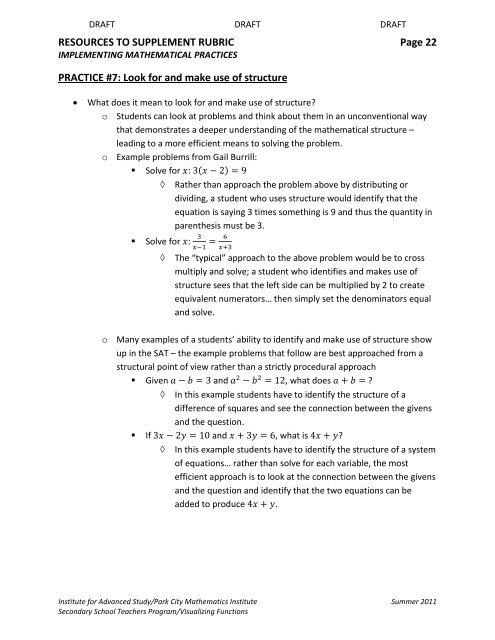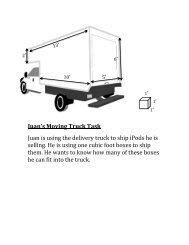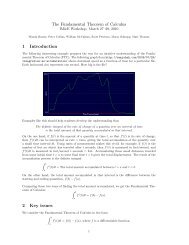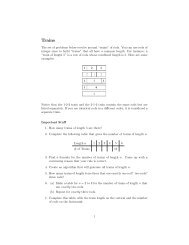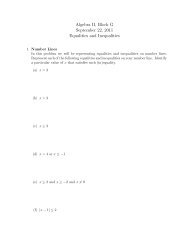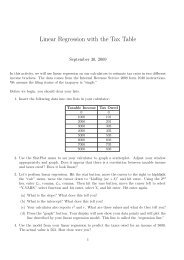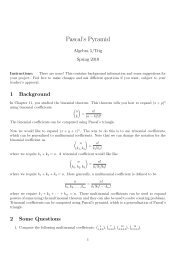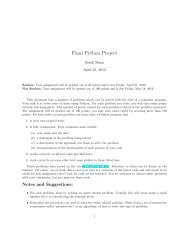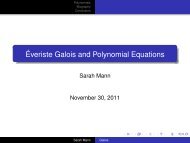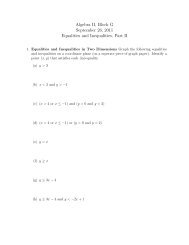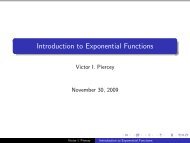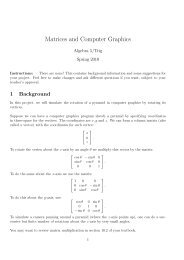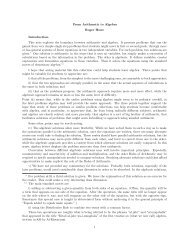Resources to supplement this rubric - Institute for Mathematics ...
Resources to supplement this rubric - Institute for Mathematics ...
Resources to supplement this rubric - Institute for Mathematics ...
You also want an ePaper? Increase the reach of your titles
YUMPU automatically turns print PDFs into web optimized ePapers that Google loves.
DRAFT DRAFT DRAFT<br />
RESOURCES TO SUPPLEMENT RUBRIC Page 22<br />
IMPLEMENTING MATHEMATICAL PRACTICES<br />
PRACTICE #7: Look <strong>for</strong> and make use of structure<br />
What does it mean <strong>to</strong> look <strong>for</strong> and make use of structure?<br />
o Students can look at problems and think about them in an unconventional way<br />
that demonstrates a deeper understanding of the mathematical structure –<br />
leading <strong>to</strong> a more efficient means <strong>to</strong> solving the problem.<br />
o Example problems from Gail Burrill:<br />
Solve <strong>for</strong> : 3( − 2) = 9<br />
Rather than approach the problem above by distributing or<br />
dividing, a student who uses structure would identify that the<br />
equation is saying 3 times something is 9 and thus the quantity in<br />
parenthesis must be 3.<br />
Solve <strong>for</strong> :<br />
=<br />
The “typical” approach <strong>to</strong> the above problem would be <strong>to</strong> cross<br />
multiply and solve; a student who identifies and makes use of<br />
structure sees that the left side can be multiplied by 2 <strong>to</strong> create<br />
equivalent numera<strong>to</strong>rs… then simply set the denomina<strong>to</strong>rs equal<br />
and solve.<br />
o Many examples of a students’ ability <strong>to</strong> identify and make use of structure show<br />
up in the SAT – the example problems that follow are best approached from a<br />
structural point of view rather than a strictly procedural approach<br />
Given − = 3 and − = 12, what does = ?<br />
In <strong>this</strong> example students have <strong>to</strong> identify the structure of a<br />
difference of squares and see the connection between the givens<br />
and the question.<br />
If 3 − 2 = 10 and 3 = 6, what is 4 ?<br />
In <strong>this</strong> example students have <strong>to</strong> identify the structure of a system<br />
of equations… rather than solve <strong>for</strong> each variable, the most<br />
efficient approach is <strong>to</strong> look at the connection between the givens<br />
and the question and identify that the two equations can be<br />
added <strong>to</strong> produce 4 .<br />
<strong>Institute</strong> <strong>for</strong> Advanced Study/Park City <strong>Mathematics</strong> <strong>Institute</strong> Summer 2011<br />
Secondary School Teachers Program/Visualizing Functions


